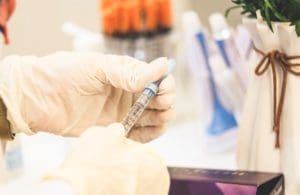
Image from Sam Moqadam on Unsplash
The rapid pace of development of COVID-19 vaccines and antibodies has redefined expectations for clinical trials. As SARS-CoV-2 variants such as Delta continue to fuel the epidemic, the industry must continue to ensure testing and clinical trials stay ahead of mutations.
To get a clearer sense of what the ramifications of this accelerated development will be for the industry at large, we spoke with Neta Bendelac, senior director of strategy at 4G Clinical, which offers software and services for clinical drug trials.
Drug Discovery & Development: What impact has the pandemic had on trials for COVID-19 therapies?
 Neta Bendelac: Speed was the most important factor for the early COVID-19 studies as many sponsors raced to get promising therapies and potential vaccines into the clinic. We all felt the urgency, all day, every day. It made sense for the FDA to stick to the gold standard of placebo trials so that the results would be clear. Unfortunately, many of the therapies didn’t have matching placebos, so the studies needed to have both blinded and unblinded staff at the clinical sites. This added an element of complexity to maintaining the blind and protecting the integrity of the data.
Neta Bendelac: Speed was the most important factor for the early COVID-19 studies as many sponsors raced to get promising therapies and potential vaccines into the clinic. We all felt the urgency, all day, every day. It made sense for the FDA to stick to the gold standard of placebo trials so that the results would be clear. Unfortunately, many of the therapies didn’t have matching placebos, so the studies needed to have both blinded and unblinded staff at the clinical sites. This added an element of complexity to maintaining the blind and protecting the integrity of the data.
DD&D: How much of a long-term impact do you foresee in terms of the clinical trial acceleration?
Bendelac: There was an element of crunch time, with everyone working overtime, but there were process innovations as well. No one cut any corners. But we learned to work seamlessly globally, bypassing the work to colleagues around the globe to follow the sun and extend the workday. In addition, there were many, many small changes in the process to scale and make tasks more repeatable. These are lessons that we can continue to lean on.
DD&D: How has the pandemic affected ongoing clinical trials in areas outside of COVID-19?
Bendelac: The pandemic was definitely a crucible for innovation. We found that sponsors could move faster if they were empowered to make changes themselves rather than having to reach out to a helpdesk. Now sponsors expect that level of control. So we’re adding even more capabilities for the sponsor as well as offering training to make sure they feel confident having more power.
For site users, we see the flip side — too much flexibility can lead to uncertainty. The systems they use need to lead them down a clear path and give them on-screen feedback, so they don’t have to break out a user manual to figure out what to do.
Recruitment was put on hold, sponsors and CROs focused on retention and ensuring patients can receive treatment. Additional countries were added, and supply issues were brought up more often at the beginning. The flexibility to make changes, amendments and move patients between sites was a necessity.
DD&D: With respect to clinical trials, how has the pandemic affected supply forecasting and reset the priorities for resilience versus agility?
Bendelac: There were many fears that supply chains would be dramatically delayed, but overall the global infrastructure continued to function. Supply teams appeared to take a hard look at potential risks, such as which countries may pose more of a challenge to ship to, and they worked more closely than ever with their clinical counterparts to mitigate these risks. However, planning requires good data, and we’ve seen an increased interest in leveraging planned and actual patient enrollment to be smarter about forecasting.
More issues came up due to longer periods for recruitment and a slowdown in clinical trial activities that led to a longer duration than expected. The lean approach caused less waste and allowed quicker adaptation to the new crisis.
DD&D: What has the pharma industry at large learned about COVID’s effects on therapeutic and vaccine development?
Bendelac: Telemedicine was rarely used before the pandemic, especially in clinical trials. That barrier has been demolished. It is imperative that sites provide medical oversight of their patients but depending on the indication, this can be done perfectly well through telemedicine. Clinical sites may not be local to patients, and remote treatment can facilitate patient recruitment, especially in indications where mobility is an issue.
This ability to cast a wider net per site can also help us recruit patients from communities that don’t often participate or are underrepresented in clinical research. I think even more important to clinical trial diversity is the attention that clinical trials have received. Many of my colleagues and I have commented that for the first time when we meet new people and tell them what we do for work, they know what we’re talking about. It’s common knowledge now. I can only hope that this will translate to a greater interest in participating in trials.
DD&D: What impact do you foresee of sponsors building direct-to-patient capabilities into their study protocols as a contingency?
Bendelac: Sponsors don’t want to be surprised again! We’ve heard from many sponsors that they are adding a standard clause to their protocols to open the door for direct-to-patient dispensing. This gives them the freedom, should they need it, for patients to receive shipments at their home rather than having to travel to the clinical site to receive their next dose. This works hand-in-hand with telemedicine, giving patients the flexibility to have access to cutting-edge therapies without having to disrupt their lives to participate in a study.
DD&D: How has the pandemic affected trial execution?
Bendelac: Sponsors and CROs are showing a great deal of interest in decentralized trials, or DCT. With the advent of telemedicine, the door is open for clinical trials to focus more on finding patients directly rather than using sites as a gateway to patients. The catch is that clinical sites are controlled environments that are regularly monitored. Patient homes are not. Telemedicine can allow a physician to connect with patients to monitor their health, but how do we ensure that their treatment is properly stored and administered? Technology can be the answer. Patients are savvier, and they expect to “have an app for that.” We can leverage that to respect their privacy while making sure they are doing what the sponsors intend.
Filed Under: clinical trials, Drug Discovery



